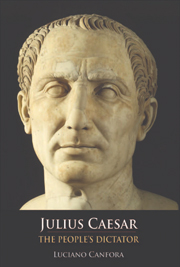Book contents
- Frontmatter
- Contents
- Translators' Note
- Acknowledgements
- Foreword
- PART I FROM SULLA TO CATILINE
- PART II FROM THE TRIUMVIRATE TO THE CONQUEST OF GAUL
- PART III THE LONG CIVIL WAR
- 16 Towards the Crisis
- 17 Striving after Tyranny?
- 18 Attacking the World with Five Cohorts
- 19 Caesar's ‘Programme’: In Search of Consensus
- 20 ‘Amicitia’
- 21 From the Rubicon to Pharsalus
- 22 Against Subversion
- 23 Alexandria
- 24 Caesar Saved by the Jews
- 25 From Syria to Zela
- 26 The Long Civil War
- 27 The Shoot of a Palm Tree: The Young Octavius Emerges
- 28 ‘Anticato’
- PART IV FROM THE CONSPIRACY TO THE TRIUMPH OF CAESARISM
- Chronology
- Bibliography
- Index
23 - Alexandria
from PART III - THE LONG CIVIL WAR
Published online by Cambridge University Press: 05 August 2013
- Frontmatter
- Contents
- Translators' Note
- Acknowledgements
- Foreword
- PART I FROM SULLA TO CATILINE
- PART II FROM THE TRIUMVIRATE TO THE CONQUEST OF GAUL
- PART III THE LONG CIVIL WAR
- 16 Towards the Crisis
- 17 Striving after Tyranny?
- 18 Attacking the World with Five Cohorts
- 19 Caesar's ‘Programme’: In Search of Consensus
- 20 ‘Amicitia’
- 21 From the Rubicon to Pharsalus
- 22 Against Subversion
- 23 Alexandria
- 24 Caesar Saved by the Jews
- 25 From Syria to Zela
- 26 The Long Civil War
- 27 The Shoot of a Palm Tree: The Young Octavius Emerges
- 28 ‘Anticato’
- PART IV FROM THE CONSPIRACY TO THE TRIUMPH OF CAESARISM
- Chronology
- Bibliography
- Index
Summary
Caesar, when that the traitor of Egypt With th' honourable head did him present, Covering his heart's gladness, did represent Plaint with his tears outward, as it is writ.
Petrarch, Canzoniere 102When Caesar reached Alexandria on 2 October 48 bc, he certainly did not expect to be greeted by the embalmed head of Pompey, but even less did he expect to be bogged down for all of nine months in a local conflict which almost cost him his life, until 28 June 47, when he finally sailed from Alexandria for Syria. Suetonius writes, correctly, that in that lengthy period Caesar found himself fighting
a war in truth of great difficulty, convenient neither in time or place, but carried on during the winter season, within the walls of a well-provisioned and crafty foeman, while Caesar himself was without supplies of any kind and ill-prepared.
It was a paradoxical war, in effect a trap of gigantic proportions: the victor of unforgettable wars and battles was besieged, with no chance of rapid reinforcements, by a very well-advised client king. The most ancient kingdom of the Mediterranean was taking its revenge on the last of many Roman generals accustomed to telling the Alexandrians what to do. Certainly there was, in the minds of Ptolemy's shrewd ‘counsellors’, an ‘Egyptian’ perspective on the episode that the Romans regarded as an interminable and inexplicable interlude in the civil war.
- Type
- Chapter
- Information
- Julius CaesarThe People's Dictator, pp. 188 - 208Publisher: Edinburgh University PressPrint publication year: 2007



